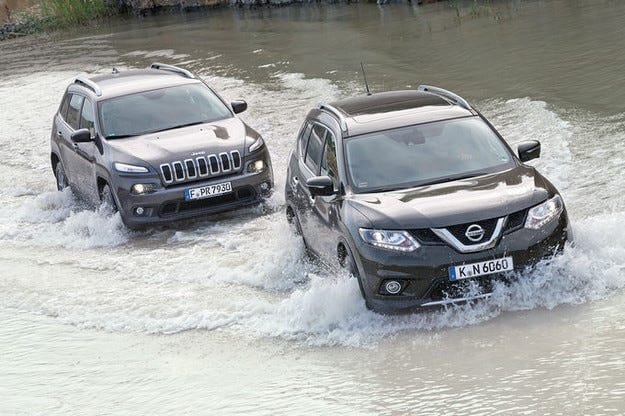
Jeep Cherokee vs Nissan X-Trail test drive: versatile talent

Fourth production Cherokee with 140 hp diesel engine. a duel against the X-Trail with 130 hp
Increasingly, the wishes and relationships of customers are becoming more important than the long tradition of car manufacturers. While most SUV model owners drive their cars almost exclusively on paved roads, they are even known for their classic SUV brands such as Jeep, they gradually came to a revolutionary decision to start offering basic versions of some of their models with only one drive axle. ...
This year, a new, fourth edition of the Cherokee debuted on the market. Against serious competition in the face of the Nissan X-Trail (built on the Qashqai technology platform) will have to show significant achievements, especially in key criteria such as interior space, comfort, fuel consumption, equipment and price. This time around, the relentless test of driving over challenging terrain passed for both competitors - short of a spectacular water crossing to capture the opening photo of this footage.
The fact that the X-Trail is 27 centimeters longer than its technological donor Qashqai brings its expected results - the nominal boot volume is an impressive 550 liters. Thanks to smart solutions such as a double boot floor and rich seat offset enhancement options, the interior really deserves to be praised for its functionality, as virtually any configuration is possible depending on specific needs, from seven seats to a gigantic cargo area. .
Despite the nearly identical wheelbase, Jeep is much more modest in this regard. Its trunk holds a total of 412 liters, and after folding the rear seats, the value rises to the not very impressive 1267 liters. Second-row passenger space is also much more limited than in the X-Trail, which has noticeably more legroom.
Two completely different characters
Only the space at the height of the second row in the jeep is larger; In Nissan, the combination of tall rear seats and a panoramic glass roof partially limits space in this direction. Otherwise, in Nissan, the driver and companion have the privilege of seating in seats with much more ergonomic upholstery than in the Jeep. Some complaints can only be about not very reliable lateral support of the case, otherwise the comfort of long walks is beyond doubt. A bit disappointing in the absence of clear contours, the very soft upholstery of the seats in the jeep.
In direct comparison, the two models show two completely different characters. The reason for this is primarily in their engines.
Jeep earns points with great comfort
Nissan only offers the X-Trail with Renault's 1,6-litre turbodiesel engine that generates 130bhp. at 4000 rpm and 320 newton meters at 1750 rpm. The two-liter Jeep unit is part of the Fiat range and offers 140 hp. at 4500 rpm and 350 newton meters at 1750 rpm. Both SUVs perform almost identically in terms of acceleration and top speed, but overall the X-Trail engine is much more unambiguously similar to itself in terms of acoustics. It also needs to maintain a little more speed and only starts to feel at home once it crosses the 2000 rpm limit - but it must be admitted that above this value it works with great enthusiasm. At higher highway speeds, the noise in the Nissan's cabin becomes annoying. On the other hand, Fiat's slightly larger engine is the more comfortable of the two drives. All in all, comfort is the discipline in which Jeep scores the most. Its chassis feels a bit softer than Nissan's, and the difference in tire size between the two cars we tested also contributes to this. While the Cherokee is stepping on 17-inch wheels, the top-of-the-line X-Trail is equipped with larger 19-inch wheels that definitely make the ride worse on rough sections of road.
In fast corners, the X-Trail 4 × 4 body tilts slightly more than the neutral Cherokee. The steering on both models is electrically assisted but precise enough for a sportier driving style. Thanks to its lower lateral tilt and lower center of gravity, the Jeep handles road tests a little more vigorously than the X-Trail and also proves to be the more agile of the two SUV models in day-to-day use, which is actually quite surprising given the slightly more weight. jeep. No less surprising, however, is the aforementioned greater weight of the American model, because unlike the X-Trail, the tested Cherokee was without a dual transmission. Weighing 1686 kilograms, Nissan is light enough for its category, which does not prevent it from towing a trailer weighing up to two tons. The Cherokee has a maximum cost of 1,8 tons.
The serious transport capabilities of both models lead us to the logical question of how reliable their braking systems are: with cold brakes, the X-Trail takes more than 39 meters to stop at 100 kilometers per hour, but it manages to compensate for the Jeep's lag through better braking with hot brakes and full load. After all, Nissan's brakes work one idea better.
At peak performance, the X-Trail isn't exactly cheap, but its equipment is frankly wasteful and includes assistance systems that can't be ordered for a Jeep. The Nissan X-Trail wins this competition on points, but the likes are probably evenly split. The front-wheel-drive version of the Cherokee is a great deal for couples who want a different style and enjoy good comfort, but travel more often alone than in the company of other people. The X-Trail is the perfect off-road vehicle for families with children who love an active lifestyle and adventure.
CONCLUSION
1.
NissanThe X-Trail wins a well-deserved victory with its rich equipment, many modern auxiliary systems and large interior volume.
2.
Jeep
The Cherokee boasts an advanced engine and better driving comfort, but not enough to win.
Text: Malte Ûrgens
Photo: Ahim Hartmann
Home " Articles " Blanks » Jeep Cherokee vs. Nissan X-Trail: versatile talent
